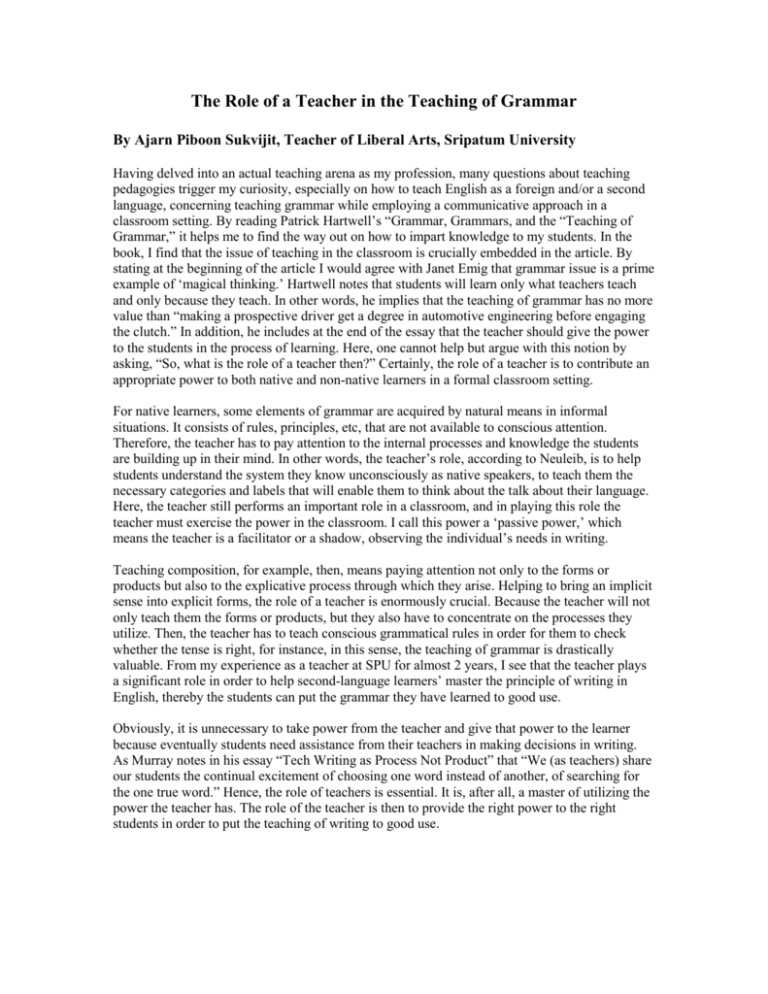12.The Role of a Teacher in the Teaching of Grammar
advertisement

The Role of a Teacher in the Teaching of Grammar By Ajarn Piboon Sukvijit, Teacher of Liberal Arts, Sripatum University Having delved into an actual teaching arena as my profession, many questions about teaching pedagogies trigger my curiosity, especially on how to teach English as a foreign and/or a second language, concerning teaching grammar while employing a communicative approach in a classroom setting. By reading Patrick Hartwell’s “Grammar, Grammars, and the “Teaching of Grammar,” it helps me to find the way out on how to impart knowledge to my students. In the book, I find that the issue of teaching in the classroom is crucially embedded in the article. By stating at the beginning of the article I would agree with Janet Emig that grammar issue is a prime example of ‘magical thinking.’ Hartwell notes that students will learn only what teachers teach and only because they teach. In other words, he implies that the teaching of grammar has no more value than “making a prospective driver get a degree in automotive engineering before engaging the clutch.” In addition, he includes at the end of the essay that the teacher should give the power to the students in the process of learning. Here, one cannot help but argue with this notion by asking, “So, what is the role of a teacher then?” Certainly, the role of a teacher is to contribute an appropriate power to both native and non-native learners in a formal classroom setting. For native learners, some elements of grammar are acquired by natural means in informal situations. It consists of rules, principles, etc, that are not available to conscious attention. Therefore, the teacher has to pay attention to the internal processes and knowledge the students are building up in their mind. In other words, the teacher’s role, according to Neuleib, is to help students understand the system they know unconsciously as native speakers, to teach them the necessary categories and labels that will enable them to think about the talk about their language. Here, the teacher still performs an important role in a classroom, and in playing this role the teacher must exercise the power in the classroom. I call this power a ‘passive power,’ which means the teacher is a facilitator or a shadow, observing the individual’s needs in writing. Teaching composition, for example, then, means paying attention not only to the forms or products but also to the explicative process through which they arise. Helping to bring an implicit sense into explicit forms, the role of a teacher is enormously crucial. Because the teacher will not only teach them the forms or products, but they also have to concentrate on the processes they utilize. Then, the teacher has to teach conscious grammatical rules in order for them to check whether the tense is right, for instance, in this sense, the teaching of grammar is drastically valuable. From my experience as a teacher at SPU for almost 2 years, I see that the teacher plays a significant role in order to help second-language learners’ master the principle of writing in English, thereby the students can put the grammar they have learned to good use. Obviously, it is unnecessary to take power from the teacher and give that power to the learner because eventually students need assistance from their teachers in making decisions in writing. As Murray notes in his essay “Tech Writing as Process Not Product” that “We (as teachers) share our students the continual excitement of choosing one word instead of another, of searching for the one true word.” Hence, the role of teachers is essential. It is, after all, a master of utilizing the power the teacher has. The role of the teacher is then to provide the right power to the right students in order to put the teaching of writing to good use.







